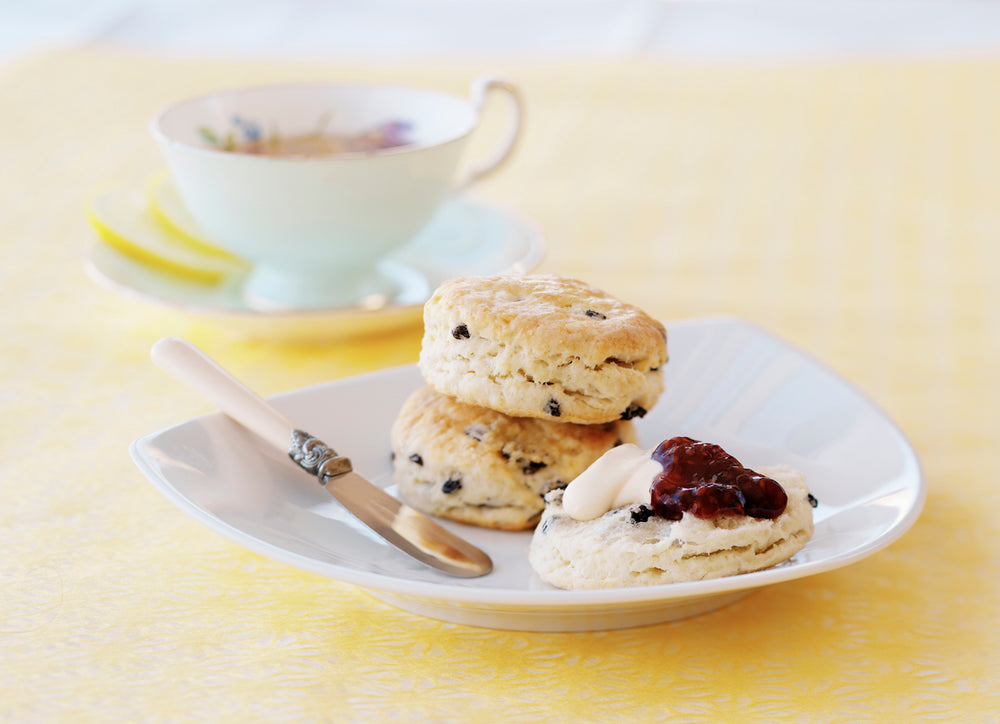Clotted cream is the best of the two most important dairy ingredients – butter and cream. It is an amalgamation of what we can say is the creaminess of whipped cream and the rich texture and taste of butter. It is a thick and luxurious cream that melts in your mouth – a perfect layer to be added to the scones along with jam. Let us explore more about clotted cream:
History of Clotted Cream

Clotted cream has its origins in the Southwestern English counties of Cornwall and Devon. It is customary in these counties to serve clotted cream with their afternoon tea.
It is estimated that around 2,000 years ago, Phoenician settlers brought the recipe of clotted cream to England for the first time. Phoenicia was located along the eastern shore of the Mediterranean Sea in what is now northern Israel, Syria, and Lebanon. Buffalo milk was preserved by clotting of the cream. They clotted the cream to preserve their milk. Removing the liquid left back the butterfat and saved it from getting bad. The people of Devonshire were aware of its effectiveness in this regard; legend has it that not even the breath of a witch could make it sour.
How is Clotted Cream Made
The best thing about clotted cream is the buttery, nutty crust that develops on top of it during manufacturing. Traditionally, it was prepared by slowly heating heavy milk or cream in large shallow pans to a temperature of 80 to 90 °C, typically using cinders or charcoal as the heat source. Once the crust was formed, it was carefully removed and stored in a cool place. The thin skimmed milk sinks and forms a layer beneath the thick cream. When the cooling process was complete, they used wet and cold hands to lift the clotted cream and then dipped it in cold and wet wooden bowls to remove any watery milk from it. They layered the clotted butter in large pots to store and savour it later.
The leftover milk was used for drinking or used in making scones.
Today big machines are used to manufacture clotted cream, but there are many small dairies spread across Devon and Cronwall that still use traditional ways to extract clotted cream. The taste of this clotted cream is authentic and heavenly when compared to the ones that are commercially produced.
Most Famous Clotted Cream Brands in Britain
Some of the companies still use traditional methods to produce clotted cream. Here is a list of some such companies that produce the creamiest clotted cream in Britain.

Trewillick Farm – A small farm that uses an artisanal approach to produce clotted cream.
Rodda's – One of the most famous brands in Cornwall that is famous all over the UK for their clotted cream. They have been producing clotted cream for over a century.
Langage Farm – Besides producing a few other dairy products, Langage also makes delicious clotted cream that gets sold in no time. They are located in Devon.
Trewithen Dairy – This dairy farm is located in Cornwall and is well-known among the locals and other counties for its rich clotted cream.
Arla – Their dairy is a major supplier of clotted cream across the supermarkets. They produce good quality clotted cream that is affordable yet tasty.
Roddas – There are several people who would rather not have any clotted cream if it is not from Roddas. They have established themselves as a prominent brand that has a loyal following.
How to Savour Scones with Clotted Cream

Scones and clotted cream are a culinary match made in heaven that has delighted palates for ages. The warm and crumbly texture of freshly baked scones pairs perfectly with the velvety richness and nutty flavor of clotted cream.
To enjoy this delightful pairing, you must first divide a scone in half, then generously top each half with a dollop of clotted cream. Add a spoonful of your preferred jam or preserves, which are typically strawberry or raspberry. (There is a huge debate as to whether the scone should be layered first with clotted cream or jam. So, you can either layer with the clotted cream first or the jam. It is entirely up to one's individual preference.)
The luxurious, thick consistency of the cream blends with the sweet and fruity jam, which is then encased by the tender scone, creating a delightful combination of textures and flavours.
Enjoy this heavenly combination with a cup of warm afternoon tea or as a special treat at any time of the day.
Clotted Cream is Versatile
The versatility of clotted cream goes far beyond its usual pairing with scones. It makes a delicious addition to various culinary creations because of its rich, creamy texture and delicate sweetness. While its taste can be best experienced when added to cold dishes, there are many dishes that people like to cook along with other ingredients. Irrespective, the taste is indeed decadent!
- It adds a sumptuous creaminess to desserts as a topping, raising pies, crumbles, and tarts.
- When drizzled over fruit salad or fresh berries, it adds a hint of indulgence.
- Clotted cream can also be spread on sandwiches or used as a luscious dip for vegetable sticks for a savoury twist.
- Additionally, it adds a velvety finish when stirred into soups or creamy pasta dishes.
The adaptability of clotted cream knows no bounds, making it a versatile ingredient that can be used with both savoury and sweet dishes.
Conclusion

While clotted cream can be enjoyed with a variety of dishes, layering it onto the scones is one of the best ways to explore its true taste. Clotted cream is a culinary treasure that enhances your dining experience.


 Christmas 2025
Christmas 2025
 Frozen Food
Frozen Food
 Baking
Baking
 Beans, Peas, Soups & Tins
Beans, Peas, Soups & Tins
 Biscuits, Crackers & Cookies
Biscuits, Crackers & Cookies
 Candy / Sweets
Candy / Sweets
 Crisps & Snacks
Crisps & Snacks
 Chemist / Pharmacy
Chemist / Pharmacy
 Desserts
Desserts
 Gravy, Stock & Paste
Gravy, Stock & Paste
 Haggis
Haggis
 Indian Sauces, Paste and Pickle
Indian Sauces, Paste and Pickle
 Jams & Preserves
Jams & Preserves
 Poppy Appeal
Poppy Appeal
 Pot Noodles & Super Noodles
Pot Noodles & Super Noodles
 Scone Mix
Scone Mix
 Gluten-Free / Free From
Gluten-Free / Free From
 Tea Accessories
Tea Accessories
 Teapot & Tea sets
Teapot & Tea sets
 Tea For One
Tea For One
 Sugar & Creamer
Sugar & Creamer
 Tableware
Tableware
 Serveware
Serveware
 Plates & Trays
Plates & Trays
 Bowls
Bowls
 Cups & Saucers
Cups & Saucers
 Mugs
Mugs
 Silverware
Silverware
 Dinnerware - Accessories
Dinnerware - Accessories
 Dinnerware - For Pets
Dinnerware - For Pets
 Victoria Eggs - Hand-Drawn UK Homeware
Victoria Eggs - Hand-Drawn UK Homeware
 Jewelry & Accessories
Jewelry & Accessories
 Sale
Sale
 Christmas Gifts
Christmas Gifts


